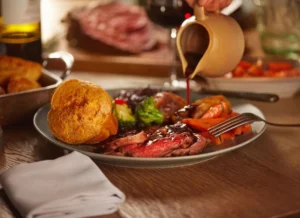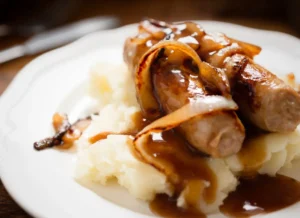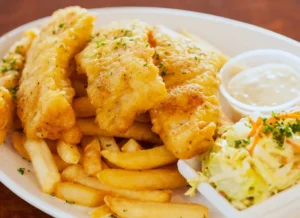This week our food columnist, Zsófi, is talking about British food, and why it has such a bad reputation throughout Europe and beyond. What are some of your favourite British dishes?
Is British Food Really Bad?
“It is commonly said,
George Orwell, 1945
even by the English themselves, that
English cooking is the worst in the world.”
Bland. Tasteless. Uninspiring. No, I am not talking about the questionable outfit choices I used to make in primary school, albeit the adjectives fit better than my skirt-on-jeans combo did at the time. Nor am I referring to the last couple of seasons of Love Island. (This might be an unpopular opinion but isn’t the same old formula of barely dressed people dancing on each other covered in foam for challenges just a little bit… tired now?)
No, despite my strong opinions on both of these topics, I won’t be discussing them in this article. This is primarily due to my persistently underdeveloped sense of style (jeans and a T-shirt is a classic, right?) and the fact that a piece on Love Island could only be done by way of extensive research into the show and I am not sure if I am ready for that sort of commitment. No, I was, in fact, talking about British cooking. Or at least most people’s general impressions of it.

British food boasts an almost unforgivable reputation. It is accused of boiling vegetables in unsalted water until they lose not only their flavour but their point. It is ridiculed for sailing around the world stealing other lands’ spices without permission or humility and refusing them entry into their own kitchens. It is distrusted for jellying eels and pairing baked beans with any type of carb imaginable (beans on toast, I can accept. But beans on pizza? We need to do better.) For adding milk into tea, and for thinking that salt and vinegar actually go together (okay, that last one is just me, I think).
And it is not just the international public that holds these opinions.
Bland. Comedian Micheal McIntyre performed a three-minute bit on salt and pepper’s rightfully audacious attitude towards the kitchen cupboard’s various other spices, given that of all of them, they were the only two in frequent use.
Tasteless. Novelist and feminist thinker Virginia Woolf described English food in her 1927 novel To the Lighthouse as an “abomination” which can be summed up as “it is putting cabbages in water. It is roasting meat until it is like leather”.
Uninspiring. Of London’s 30 best restaurants, only six serve British food, with the other 24 dishing up gastronomic wonders from different parts of the world such as Sri Lanka, Spain, or Israel.
To me, however, British food’s abominable reputation was not something to be believed. My arrival to this land was marked by an instant fascination with its food culture.
I became a regular at the farmers’ markets where good-quality, fresh, organic produce was in abundance. I was on “let’s smile at each other and exchange a couple of words on the football game only you watched” terms with the local street food vendors and their stalls that were pitched haphazardly on the uneven cobblestones. I celebrated special occasions in different restaurants – even if the special occasion was just surviving another lecture of “Syntax: Theory and Practice”.
I did my weekly shopping in various shops. Of course, sauerkraut and kefir had to be bought from the Polish shop. My gochujang and udon noodles could only be sourced from the Chinese supermarket. And well, let’s not forget about the black lentils and whole coriander seeds that I only found at the Indian shop.
Everywhere was abounding, everything within an arm’s reach, all out to excite you and call out to your stomach as it searches for the next culinary adventure. Now you see why I refused, yes, outright refused the idea that in a country of such gastronomic richness, native people’s food could be so… well, bad.
More on European Food: The Scottish Art of Deep-Frying Everything
So… What is British food?
Of course before we embark on our qualitative evaluation of British food, it is essential that we understand what it is exactly. I know what you’re thinking: this question seems futile at the most and self-evident at the least.
But hear me out: the British Isles give home to a diverse range of food cultures and most Brits I know live international and well-travelled culinary lives, even if they have never left the country they were born in. Just think about the fact that alongside the Sunday roast and fish and chips, Chicken Tikka Masala is officially one of the three national foods of the country!
Or consider the overwhelming success of fusion restaurants such as Roti Food & Liquor which serves dishes wherein the quintessential British staples are mixed with Indian influences – try out for example the Mini Fish and Masala Potatoes or Haggis Pakora MCN.
Yes, British food is simple and mostly unseasoned. But this is exactly why it lends itself so perfectly to innovation and the imagination of the island’s chefs – as well as to influences from international cooking – that work on constantly reinventing the cuisine to give it the dynamicity that it has today.
Stripped back to its basics, however, British food is uncomplicated. It is food that is defined by the country’s imperial history as well as its internal struggles. While due to the infamous rainy weather, many fruits, vegetables, and herbs and spices were historically unavailable for British cooks, trade routes established as part of the fatal British Empire allowed for new ingredients – and ideas – to infiltrate British culinary traditions. Spices transported from India revolutionised British cooking perhaps the most prominently: it would be difficult to find a professional kitchen now where cumin, paprika, and coriander are lacking.
Historically, however, British food is not marked by a richness in flavour – or in fact, a richness of any kind. Food, and especially food in Britain, is inextricably linked to the poverty experienced by the majority of the population whose priorities in their culinary lives were feeding mouths fast and efficiently. This is why many quintessential British dishes are hearty and filling while using minimal ingredients and energy. The aim is to be cost-efficient, and to get you through the bleakest of winters relatively well-fed.
As a Hungarian person, my understanding of British food is somewhat external to the adversity that is so inherent in this cuisine. As such, I have decided to listen to some British voices on their opinions of their traditional dishes and their history. Many of my friends expressed that British food gives them great comfort and nostalgia, and while they know that bangers and mash may not be the dish for a sunny day in Costa del Sol, they believe it is perfect to consume on a cold winter day in an old haunt. In fact, my flatmate, born and raised in Manchester, spoke of the British staple, beans on toast in such terms:
“Beans on toast, a dish often widely ridiculed around the world, tells the story of the struggles for the working class of Britain today whilst simultaneously providing many with a great sense of comfort. A warm and substantial meal that costs little to make as it can be prepared entirely using a toaster and microwave. The ingredients are simple and energy usage is low. In a country where parents are going without food in order to feed their children, where schools are providing breakfast for pupils whose parents have to work and free school meals extending into the holidays, beans on toast is a staple and provides us with another story of survival.”
More on European Food: What to Order in a Portuguese Pasteleria
Some British dishes that you might just love
So, if it does take your fancy to try some of the national cuisine here, let me recommend you four dishes that you cannot miss.
The Classic Sunday Roast

What do the royal guards and roast potatoes have in common? This is not the opening line of a joke (although I am still wracking my brain to find a punchline to match), but a fun fact you may not know about your weekly Sunday dinners.
Ever wondered why we call the royal guards with the tall fluffy hats “beefeaters”? Well, back in the 15th century beef, and especially roast beef, started gaining immense popularity among the British. After every Sunday service, the royal guards would gather for their dinner which consisted primarily of roast beef. It is because of these weekly dinners that they gained their affectionate nickname.
But it wasn’t just the guards that indulged in this new trend: families across the country would take their uncooked beef to their local baker’s – which generally weren’t baking delicious bread on Sundays and therefore whose ovens were free to use – and return home from the service with a little detour to the baker’s where they picked up their perfectly roasted beef.
Back then, the crowning jewel of the roast dinner was the meat which was then served with roasted vegetables and preceded by an appetiser plate of Yorkshire pudding and gravy.
Roast dinners have now evolved into full plates of meat of your choice, roast potatoes and other root vegetables, often carrots and parsnips, Yorkshire pudding, peas, and gravy, of course. The importance of this dish, however, has not diminished over the years: A 2012 UK poll has shown that a roast dinner is second in a list of things people love about Britain (just below a bacon sandwich). And no wonder: it is easy to prepare, cost-effective, and a real comfort experience.
A note for the fellow vegetarians out there: While the history of this dish is strongly connected to the beef, nowadays, there are many options for us herbivores to enjoy a roast without having to fill our plates solely with potatoes, carrots, and parsnips. The main piece of a vegetarian roast may be a Wellington, which consists of vegetables wrapped in pastry and baked to a crispy finish, any vegetable pie of your choice, or, my favourite, a nut roast.
This latter is a mixture of nuts, vegetables, and lentils baked to perfection in a loaf tin, seasoned with garlic, parsley, and lemon. I guarantee that a nut roast is a hit at any dinner table, and the reason why I can guarantee it is because my mother, who is wildly allergic to nuts, couldn’t refuse a taste from this steaming veggie goodness when I set it in front of her. I highly recommend it!
Bangers and Mash

If you are like me, as in not British, you may have looked at the words ‘bangers and mash’ in succession and thought: uhm, eating mashed potatoes to very good music sounds eccentric, but so is celebrating a failed attempt to blow up Parliament every November, so it sounds just about right. And then went on with your day.
Well, I can now share a piece of wisdom with you that I only found out when I finally had enough of my confusion and googled this dish under a table at Wetherspoons. Bangers are actually sausages that supposedly acquired this nickname around World War I when food shortages led to sausages being filled with water and other non-meat substances which caused them to explode with a loud bang when cooking.
This is an incredibly simple but wildly popular pub grub and homemade weekday dish, consisting solely of mashed potatoes, sausages, and, of course, onion gravy. Vegetarians and vegans may enjoy this dish with vegan sausages (thank you, Linda McCartney).
Fish and Chips

Similar to many other legendary innovations, the history of fish and chips is also unclear. Fried fish took off first in London’s East End and chips were a staple in the north of England, especially in Lancashire.
We may never know who we may thank for combining the two ingredients to create the emblematic dish of the nation, but it gained immense popularity in World War I when fish and potatoes were two of the few ingredients not rationed and as such, contributed massively to feeding the nation.
There are about 10.500 fish and chip shops currently and this number is just growing. If you’re ever in the UK, it is absolutely essential that you try fish and chips, preferably on a stoney beach, out in the cold, while battling with seagulls for your food. The important thing you can’t forget about fish and chips: it is only ever as good as the ingredients! Make sure your fish is a good-quality cod or haddock and your chips are made from fresh potatoes.
Toad in the Hole

Speaking to the non-British readers again, this is another doozy. Toads? In holes? Considering these names, the cuisine’s bad reputation certainly makes sense to me. However, just as you shouldn’t judge a book by its cover, it’d be wise not to judge toad in the hole by its name, or for that matter, by its looks (because let’s be honest, it does not look appetising.)
Another incredibly simple dish that was first invented around the 18th century. As meat was an expensive ingredient, families aimed to make meat last longer in the household. In this dish, they bulk the meat out with plenty of Yorkshire pudding, which was much cheaper to make or source. This dish is served with gravy and mashed peas, which give it its comforting flavour.
The name is a reference to toads lying in their burrows waiting for their prey, an image apparently similar to sausages lying in Yorkshire pudding. Toad in the hole is the ultimate dish for British winters, and best enjoyed by the fireplace in an old man’s pub.

Great post! It’s true British food has a bad reputation haha, but these dishes are so delicious 🙂 I like the fact that diverse global populations have influenced our national cuisine – we should appreciate the food and culture of everyone that lives here x
Yes, totally agree! It’s such a good manifestation of how diverse the population is 🙂
True just like the usa
I toldly agree